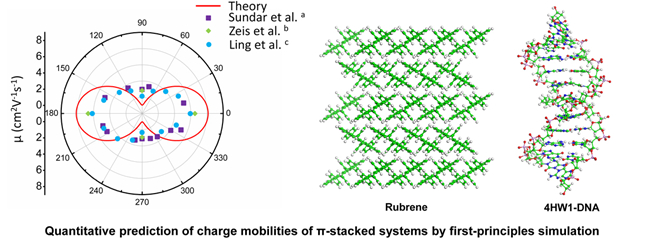Profs. Ke-Li Han and Wei-Qiao Deng from the State Key Laboratory of Molecular Reaction Dynamics at Dalian Institute of Chemical Physics just published new results predicting the charge carrier mobilities of π-stacked systems, which are used in electric devices. The research paper titled “Quantitative prediction of charge mobilities of π-stacked systems by first-principles simulation” was published in Nature Protocols (2015, Volume 10, Pages 632–642).
π-stacked systems are an important feature in organic semiconductors, liquid crystals, and even in DNA. The presence of strong intermolecular π-π coupling effects in π-stacked systems facilitates charge transfer between adjacent molecules. This feature of π-stacked systems makes them very useful in electric devices, such as organic field-effect transistors and DNA molecular wires. Unlike traditional inorganic semiconductors, charge transfer in organic π-stacked systems behaves in such a way that conventional semiconductor theory approach cannot be used to explain charge migration. Moreover, due to the diversity of organic molecules, there are many possibilities for structures of π-stacked systems. The critical issue thus becomes how to create a material that has required properties and functions. New theoretical approaches to predict charge transfer in π-stacked systems thus are an important way to explore the properties of myriad molecular structures without having to synthesize them.
In 2009, Profs. Han and Deng developed a theoretical approach combining Marcus theory and quantum chemistry calculations that could accurately predict the anisotropic charge mobilities in organic semiconductors (J. Phys. Chem. B 2009, 113, 8614). Through many years of development, they have gradually refined their approach and successfully used it to study a series of organic semiconductor materials (Chem. Commun. 2010,46,5133; Phys. Chem. Chem. Phys., 2010, 12, 9267). In this newest article, a computational approach was developed to predict the charge mobility using only a crystal structure of π-stacked systems. The theoretical results obtained coincide well with experiments.
These newly published results are important in that they bring new insight to the organic electronics field by establishing a basis for large-scale screening of π-stacked systems.

This work is financially supported by National Natural Science Foundation of China and the Basic Research Program of China (973 Project). (By Lei Sun)